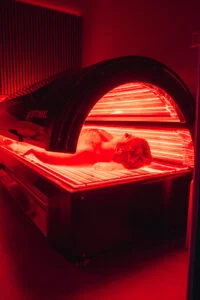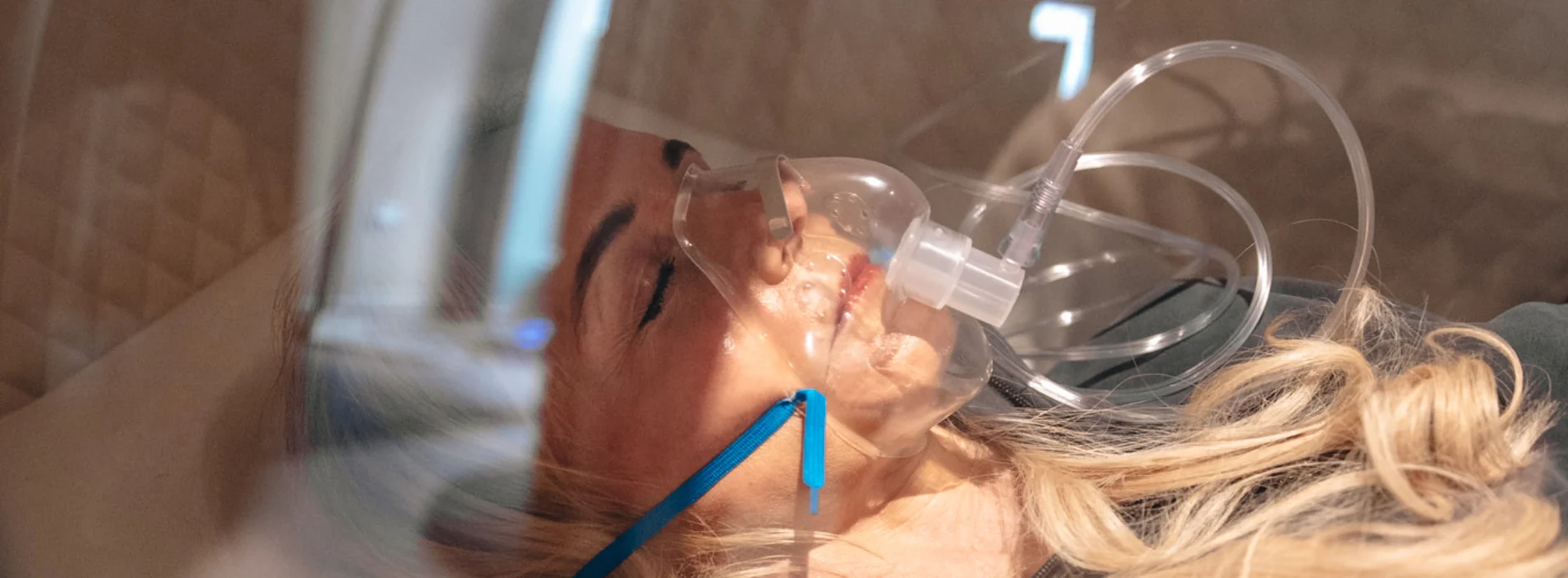The Restorative Benefits of Red Light Therapy & HBOT for Sleep
Struggling to get a good night’s sleep? You’re not alone. Over one-third of the UK population lives with chronic sleep deprivation, a problem that can disrupt your work, relationships, and overall well-being.
Many people turn to over-the-counter medications for relief. However, these options usually only offer short-term results and can carry unwanted side effects.
For those seeking more natural, science-backed alternatives, red light therapy and hyperbaric oxygen therapy (HBOT) are emerging as effective sleep solutions.
Read on to find out why uninterrupted rest is so important and why you can turn to HBOT and red light therapy for better sleep.
Ready to sleep better? Begin your wellness journey today with red light therapy and hyperbaric oxygen therapy sessions at Re:nu London.
Why Quality Sleep Is Essential for Your Health
When you’re asleep, your body does some of its best work. It’s a restorative time for your immune system to strengthen its defences and for tissues to repair and regenerate. How deeply you sleep comes down to your circadian rhythm—your internal 24-hour body clock that tells you when to feel awake and when to feel sleepy.
However, if your natural sleep patterns are disrupted (stress, screen time, caffeine, late dinners, shift work, and other lifestyle factors), it can have wide-ranging effects on your body, mind and overall quality of life.
Constantly missing out on quality rest impacts everything from your mood and concentration to cardiovascular health and hormone balance. Over time, this can lead to chronic sleep deprivation or insomnia, leaving you tired, irritable, and more susceptible to illness.
Red Light Therapy for Sleep
Devices that emit blue light suppress melatonin, the hormone that regulates your body’s internal clock and sleep-wake cycle. That’s what keeps you awake. Red light does the opposite.
One of the biggest red light therapy sleep benefits is that it boosts melatonin production for improved sleep quality. It does this by stimulating melatonin-producing cells in the pineal gland, which in turn, tell the brain that it is night and time to wind down.
It can also realign circadian rhythms and reduce cortisol levels in the body, the stress hormone that’s normally low at night but can stay elevated due to frequent sleep disturbances or deprivation. This will make it much easier to fall asleep and stay asleep until morning.
The experience inside a red light therapy bed is one of calm and relaxation. Regular use can therefore lead to deeper, more restful sleep by enhancing overall sleep quality and duration.

Hyperbaric Oxygen Therapy for Sleep
Many sleep disorders are caused by low oxygen levels, and this is how hyperbaric oxygen therapy (HBOT) can help. Among the key HBOT benefits for sleep disorders is how it increases oxygen levels in the body.
The treatment involves breathing concentrated oxygen while enclosed in a specially designed chamber. The increased pressure allows the lungs to absorb more oxygen, enhancing the body’s ability to deliver it to tissues and the brain.
This can improve how soundly you sleep, as optimal oxygenation supports healthy cognitive function and mood—all essential ingredients for a good night’s rest.
On a cellular level, HBOT contributes to repairing tissue damage. This can aid faster recovery from the pain and discomfort of any injuries that keep you up at night.
Sessions of HBOT for sleep can also ease tension in the mind as well as the body. Closing your eyes and relaxing in the chamber will reduce stress and encourage mental clarity.
Combining Therapies for Better Results
Does red light therapy work for sleep when used alongside hyperbaric oxygen therapy? Yes, it does.
When undertaken one after the other, red light therapy and HBOT synergise, complementing and enhancing each other’s benefits. This leads to even better rest-promoting results by supporting the body’s natural healing process on multiple levels.
Red light improves circulation, increasing blood flow so oxygen-rich blood can reach deeper tissues and damaged areas during HBOT treatments. Both also reduce inflammation, calm the nervous system, and lower oxidative stress—key factors linked to disrupted sleep.
To get the best out of both therapies, it’s ideal to start with red light therapy to prep your cells for better oxygen absorption, then follow with HBOT for a deeper, longer-lasting impact on sleep quality.
Get Natural Sleep Solutions at Re:nu London
At Re:nu Wellness Centre, our results-driven biohacking treatments for sleep are delivered through our state-of-the-art equipment.
Our red light therapy bed is decked out with 42,000 individual LEDs and a blend of red and near-infrared wavelengths to provide full-body coverage. Our AeroVita™ F85 steel hyperbaric chamber (mattress and pillow included) delivers 95% oxygen under pressure via a comfortable, fitted face mask.
Both of these professional therapies will be tailored to your individual needs and goals, and you can choose between single sessions or multi-session package prices.
Want to get a better night’s sleep? Call the friendly team at Re:nu London today on 020 3972 0182 or schedule your first session online now.
Sleep Optimisation FAQs
How Does Red Light Therapy Improve Melatonin Production?
Red light, particularly in the 600–700 nm wavelength range, is like a signal to the brain to start relaxing. This stimulates the body’s natural rise in melatonin, promoting better sleep quality.
Can Hyperbaric Oxygen Therapy Help With Sleep Apnoea?
People are turning to hyperbaric oxygen therapy for sleep apnea because, as it increases the amount of oxygen in the body, it helps reduce inflammation in the airways and supports more restful breathing at night.
Are These Treatments Safe for Long-Term Sleep Issues?
Yes, both are considered safe when used as directed. Red light therapy can cause mild redness or eye sensitivity if unshielded, while HBOT sessions should be supervised to avoid complications like sinus damage or ear pressure changes. Always consult a healthcare professional first, especially if you have underlying health conditions, to ensure the treatment is right for you.
How Many Sessions Are Needed to See Sleep Improvements?
People often see sleep benefits after 4-6 weeks, if they consistently attend treatments 2-3 times per week. For significant improvements, it’s recommended to do a total of 20 to 60 sessions.

About the Author
Pat Viroux is a seasoned wellness expert and visionary member of the advisory board here at Re:nu Health, London. With over 20 years’ experience in the wellness industry, Pat champions scientific research and innovative therapies to provide accessible wellness solutions that inspire and transform lives.
While Re:nu treatments can support performance, recovery, and wellness, individual results may vary. Advice given is not intended to diagnose or treat any medical condition. The advice shared in this article is based on scientific evidence regarding how Hyperbaric Oxygen Therapy (HBOT) may support recovery from long COVID. It should not be considered as guidance on how to directly treat COVID. Always consult a medical professional before beginning a new treatment regime.
